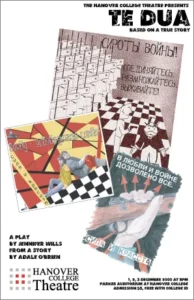This is marketing artwork from Te Dua, a play by Jennifer Wills from a true story developed by Adale O’Brien, which won the Forth Freedom Playwriting Award at the Kennedy Center American College Theatre Festival in 2001. It’s the true story of two people on different sides of the conflict in Sarajevo, told (in this draft) with imagery from board games and strategy games. I probably don’t have to tell you that it’s a tragedy in the end. It’s a fine play, and I hope we get to see how it’s developed since the Hanover production.

Each of these images anchored their own posters, with all three appearing on the program covers.
I’m going to have to revisit this post at a later date, because I don’t have the translations handy. But I managed to translate several phrases, some from the play directly, some thematically in line with the play, and used them as the propaganda slogans in the artwork. (I’ll also include a larger version of the artwork as well…)
For the imagery itself, I knew from the first reading that the artwork would be Soviet-style propaganda art. I knew some already, researched more, sparking to the work of artists like Valentina Kulagina, Litvak, the Stenberg brothers, and particularly the works of Vladimir Mayakovsky and Alexander Rodchenko. (These links are all from the A Soviet Poster A Day blog, which is inactive. It didn’t exist when I was doing my initial research.)
The top image, with Uncle Moneybags (or whatever they’re calling him these days), plays with the board game themes in the script, using Monopoly as a dual-edged reference to Communist Russia. The bottom image, with the fist, is more directly inspired by some actual posters. Both of these were hand-drawn.
The central image, which was also the primary artwork, is a collage of drawn elements, typography and photography, featuring the lead actors from the production.
As good as the show was, and as much as people liked the artwork, the best part of the experience for me was when we managed to get copies of the artwork to the actual soldier whose story inspired the play. He was stunned at the wording in the posters–and stunned that it was translated properly–but knew immediately what original artwork had inspired which element in each poster. He was amazed that anyone here in southern Indiana knew Mayakovsky or would design art in his and Rodchenko’s styles. That he loved the art meant a lot.
If you’d like to set the mood, listen to Vrbana Bridge by Jill Sobule (at Amazon or iTunes). This is the song that essentially opened the show, a similarly tragic story in the same setting.
To close the show, the theatre commissioned an original song by Tamara Dearing, of whom you’ve heard a little on this blog already. (If you haven’t, go check out Suo Gan.) She recorded two versions, an instrumental for the actual ending and a second version with lyrics for the curtain call. This is the one with lyrics.
It’s also where the title of this post comes from.
<font=-2>Te Dua by Tamara Dearing is licensed under a Creative Commons Attribution-Noncommercial-No Derivative Works 3.0 United States License.
Permissions beyond the scope of this license may be available at http://www.tamaradearing.com.</font=-2>



Leave a Reply
You must be logged in to post a comment.